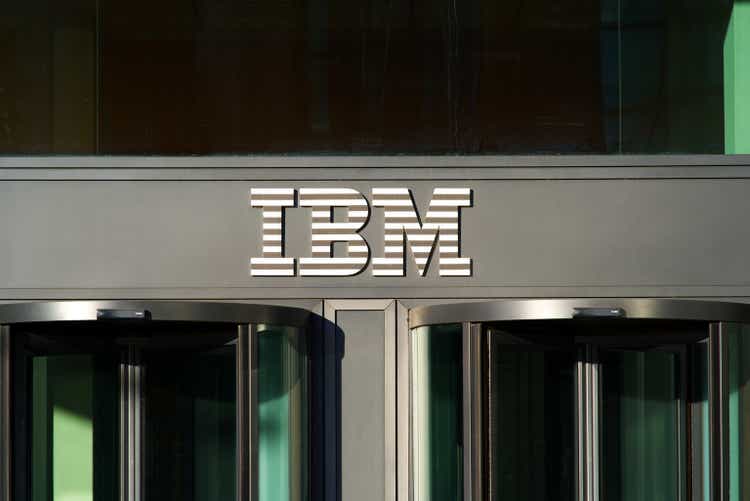Michael Derrer Fuchs/iStock Editorial via Getty Images
Shares of IBM (NYSE:IBM) have been doing quite alright as this boring old-tech player has been a real outperformer given the turmoil and slaughter in the wider technology space, and even general equity markets.
My last take on the business goes back to April 2020, when the world was in turmoil given the outbreak of the pandemic as I concluded that low valuations did not automatically create appeal as more disappointments were showing up.
A Look Back
Little over 2 years ago, I observed that IBM posted real revenue declines despite a huge Red Hat deal announced before, which was supposed to fix things. The Red Hat deal was huge and with a $34 billion price tag was equivalent to $40 per share in terms of IBM’s stock, yet the organic growth contribution of 1% was by far not sufficient to offset legacy revenue declines.
Upon the deal announcement of Red Hat in 2018, net debt could double to $68 billion overnight, although that would come down to $49 billion if we factor in financing receivables and net pension liabilities as well, still a steep debt position and essentially a 3 times leverage number with EBITDA posted at $16.5 billion, as the company guided for adjusted earnings just shy of $14 per share in 2019. In the end, it turned out that adjusted earnings fell to $12.81 per share in the year.
In April 2020 the company just posted a 3% fall in sales to $17.6 billion even as the quarter included a $719 million revenue contribution from Red Hat. Including deferred revenues and intercompany adjustments, Red Hat added over a billion in sales and reported near 20% growth rates, still hardly making a dent.
With first quarter adjusted earnings only coming in at $1.84 per share, there were few silver linings other than that net debt fell to $33 billion as cash flows generation was solid. With shares trading at just over $100, the valuations were low, but operational performance was disappointing as earnings came in under pressure, as the transition of IBM has been long in the making.
Doing Quite Alright
Since shares traded at $110 in April 2020 shares have been trading range bound between $100 and $140 in the period thereafter, now actually trading at the higher end of the range.
2020 has proven to be a difficult year, which is not a surprise, as revenues fell from $77.2 billion to $73.6 billion and GAAP earnings came down from $9.4 billion to $5.6 billion. Essentially, every dollar in revenue declines hit the bottom line in a one-to-one ratio. GAAP earnings came in at $6.23 per share, as even very adjusted earnings fell to $8.67 per share, as I am quite skeptic on some of these adjustments.
The 2021 results were completely different as IBM announced the separation of Kyndryl into an independent publicly traded company. Kyndryl (KD) started trading at a price of $40 in the autumn of last year, and shares have now been decimated to just $10 per share, translating into a market value just above the $2 billion mark for this spin-off. Kyndryl is the largest IT infrastructure provider, a huge business with some $17 billion in annual sales but essentially not posting any profits. These results are of course subtracted from the overall reported revenues and profits of IBM, cutting its sales meaningfully, but boosting growth and margins.
So if we factor out this revenue contribution in 2021 we see IBM posting sales of $57.3 billion, up more than two billion on the year before. Income from continuing operations rose by $0.8 billion to $4.7 billion, as income from discontinued operations of a billion translates into earnings of $5.7 billion.
Sales momentum accelerated early in this year with revenues up 8% to $14.2 billion, even up 11% in constant currency terms. A recovery in the consulting revenues and relative larger share of a solid performing software business have been driving growth. That is about the good news as net earnings of $733 million fell, amidst falling earnings from discontinued operations, as earnings were posted at $0.82 per share.
While adjusted earnings of $1.40 per share look a lot better, some adjustments, notably related to retirement liabilities seem quite aggressive. The positive news is that my broad definition of net debt (so including financing receivables and net pension liabilities) has fallen to $28 billion. Still, earnings power trends at $6 per share at best, even if we believe the adjusted earnings metrics.
What Now?
Compared to recent years, the dividend yield of $1.65 per share on a quarterly basis continues to be attractive, although the relative attractiveness has diminished given the higher interest rate environment. Furthermore, headwinds will materialize as well as the company has to refinance some of its debt load.
The reality is that following the spin-off, the company has seen huge valuation multiple inflation. With earnings power now trending at $6 per share, albeit that the company sees higher cash flows, valuation multiples are elevated at around 23 times earnings at $140, while IBM has traditionally traded at just 10-12 times earnings in recent years.
Given the recent strong dollar and softening economic conditions, I see real risks to the guidance as well, as all of this makes me quite cautious, certainly given the recent outperformance as of late, as the multi-year transition continues at a very modest pace.


Be the first to comment